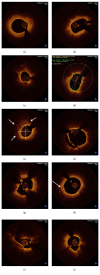New Insights into the Association between Fibrinogen and Coronary Atherosclerotic Plaque Vulnerability: An Intravascular Optical Coherence Tomography Study
- PMID: 31772619
- PMCID: PMC6740041
- DOI: 10.1155/2019/8563717
New Insights into the Association between Fibrinogen and Coronary Atherosclerotic Plaque Vulnerability: An Intravascular Optical Coherence Tomography Study
Abstract
Background: Fibrinogen levels have been associated with coronary plaque vulnerability in experimental studies. However, it has yet to be determined if serum fibrinogen levels are independently associated with coronary plaque vulnerability as detected by optical coherence tomography (OCT) in patients with coronary heart disease.
Methods: Patients with coronary heart disease (CHD) who underwent coronary angiography and OCT in our department from January 2015 to August 2018 were included in this study. Coronary lesions were categorized as ruptured plaque, nonruptured with thin-cap fibroatheroma (TCFA), and nonruptured and non-TCFA. Presence of ruptured plaque and nonruptured with TCFA was considered to be vulnerable lesions. Determinants of coronary vulnerability were evaluated by multivariable logistic regression analyses.
Results: A total of 154 patients were included in this study; 17 patients had ruptured plaques, 15 had nonruptured plaques with TCFA, and 122 had nonruptured plaques with non-TCFA. Results of univariate analyses showed that being male, diabetes, current smoking, high body mass index (BMI), and clinical diagnosis of acute coronary syndrome (ACS) were associated with coronary vulnerability. No significant differences were detected in patient characteristics, coronary angiographic findings, and OCT results between patients with higher and normal fibrinogen. Results of multivariate logistic analyses showed that diabetes and ACS were associated with TCFA, while diabetes, higher BMI, and ACS were associated with plaque rupture.
Conclusions: Diabetes, higher BMI, and ACS are independently associated with coronary vulnerability as detected by OCT. Serum fibrinogen was not associated with coronary vulnerability in our cohort.
Copyright © 2019 Jun Wang et al.
Conflict of interest statement
The authors declare that they have no conflicts of interest.
Figures



Similar articles
-
Association between Gamma-Glutamyl Transferase and Coronary Atherosclerotic Plaque Vulnerability: An Optical Coherence Tomography Study.Biomed Res Int. 2019 Mar 4;2019:9602783. doi: 10.1155/2019/9602783. eCollection 2019. Biomed Res Int. 2019. PMID: 30984786 Free PMC article.
-
Mean platelet volume and coronary plaque vulnerability: an optical coherence tomography study in patients with non-ST-elevation acute coronary syndrome.BMC Cardiovasc Disord. 2019 May 29;19(1):128. doi: 10.1186/s12872-019-1115-2. BMC Cardiovasc Disord. 2019. PMID: 31142268 Free PMC article.
-
Elevated levels of systemic pentraxin 3 are associated with thin-cap fibroatheroma in coronary culprit lesions: assessment by optical coherence tomography and intravascular ultrasound.JACC Cardiovasc Interv. 2013 Sep;6(9):945-54. doi: 10.1016/j.jcin.2013.04.024. Epub 2013 Aug 14. JACC Cardiovasc Interv. 2013. PMID: 23954061
-
Prevalence and predictors of culprit plaque rupture at OCT in patients with coronary artery disease: a meta-analysis.Eur Heart J Cardiovasc Imaging. 2016 Oct;17(10):1128-37. doi: 10.1093/ehjci/jev283. Epub 2015 Oct 27. Eur Heart J Cardiovasc Imaging. 2016. PMID: 26508517 Review.
-
What have we learned about plaque rupture in acute coronary syndromes?Curr Cardiol Rep. 2010 Jul;12(4):338-43. doi: 10.1007/s11886-010-0113-x. Curr Cardiol Rep. 2010. PMID: 20425160 Review.
Cited by
-
Magnesium Sulfate Improves Some Risk Factors for Atherosclerosis in Patients Suffering from One or Two Coronary Artery Diseases: A Double-blind Clinical Trial Study.Clin Pharmacol. 2020 Sep 25;12:159-169. doi: 10.2147/CPAA.S261264. eCollection 2020. Clin Pharmacol. 2020. PMID: 33061673 Free PMC article.
-
Fibrinogen and Atherosclerotic Cardiovascular Diseases-Review of the Literature and Clinical Studies.Int J Mol Sci. 2021 Dec 24;23(1):193. doi: 10.3390/ijms23010193. Int J Mol Sci. 2021. PMID: 35008616 Free PMC article. Review.
-
Early Diagnosis and Treatment of Coronary Heart Disease with Image Features of Optical Coherence Tomography under Adaptive Segmentation Algorithm.Comput Math Methods Med. 2022 Aug 8;2022:1261259. doi: 10.1155/2022/1261259. eCollection 2022. Comput Math Methods Med. 2022. PMID: 35979043 Free PMC article.
-
Endothelial Dysfunction, Inflammation and Coronary Artery Disease: Potential Biomarkers and Promising Therapeutical Approaches.Int J Mol Sci. 2021 Apr 8;22(8):3850. doi: 10.3390/ijms22083850. Int J Mol Sci. 2021. PMID: 33917744 Free PMC article. Review.
-
Serum total bilirubin and long-term prognosis of patients with new-onset non-ST elevation myocardial infarction: a cohort study.BMC Cardiovasc Disord. 2022 Apr 12;22(1):165. doi: 10.1186/s12872-022-02607-8. BMC Cardiovasc Disord. 2022. PMID: 35413813 Free PMC article.
References
Publication types
MeSH terms
Substances
LinkOut - more resources
Full Text Sources
Medical
Miscellaneous
